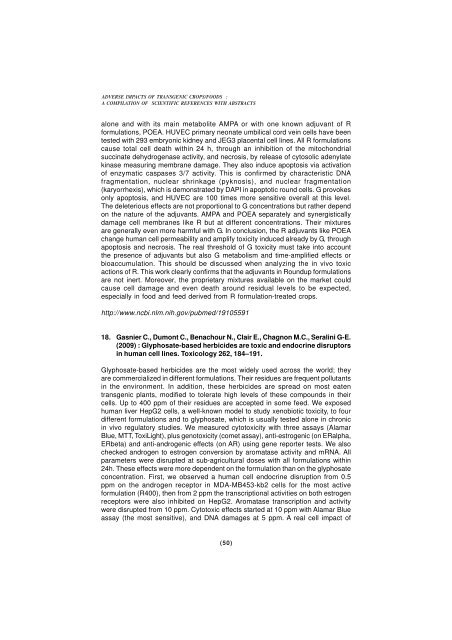omb3dyw
omb3dyw
omb3dyw
Create successful ePaper yourself
Turn your PDF publications into a flip-book with our unique Google optimized e-Paper software.
ADVERSE IMPACTS OF TRANSGENIC CROPS/FOODS :A COMPILATION OF SCIENTIFIC REFERENCES WITH ABSTRACTSalone and with its main metabolite AMPA or with one known adjuvant of Rformulations, POEA. HUVEC primary neonate umbilical cord vein cells have beentested with 293 embryonic kidney and JEG3 placental cell lines. All R formulationscause total cell death within 24 h, through an inhibition of the mitochondrialsuccinate dehydrogenase activity, and necrosis, by release of cytosolic adenylatekinase measuring membrane damage. They also induce apoptosis via activationof enzymatic caspases 3/7 activity. This is confirmed by characteristic DNAfragmentation, nuclear shrinkage (pyknosis), and nuclear fragmentation(karyorrhexis), which is demonstrated by DAPI in apoptotic round cells. G provokesonly apoptosis, and HUVEC are 100 times more sensitive overall at this level.The deleterious effects are not proportional to G concentrations but rather dependon the nature of the adjuvants. AMPA and POEA separately and synergisticallydamage cell membranes like R but at different concentrations. Their mixturesare generally even more harmful with G. In conclusion, the R adjuvants like POEAchange human cell permeability and amplify toxicity induced already by G, throughapoptosis and necrosis. The real threshold of G toxicity must take into accountthe presence of adjuvants but also G metabolism and time-amplified effects orbioaccumulation. This should be discussed when analyzing the in vivo toxicactions of R. This work clearly confirms that the adjuvants in Roundup formulationsare not inert. Moreover, the proprietary mixtures available on the market couldcause cell damage and even death around residual levels to be expected,especially in food and feed derived from R formulation-treated crops.http://www.ncbi.nlm.nih.gov/pubmed/1910559118. Gasnier C., Dumont C., Benachour N., Clair E., Chagnon M.C., Seralini G-E.(2009) : Glyphosate-based herbicides are toxic and endocrine disruptorsin human cell lines. Toxicology 262, 184–191.Glyphosate-based herbicides are the most widely used across the world; theyare commercialized in different formulations. Their residues are frequent pollutantsin the environment. In addition, these herbicides are spread on most eatentransgenic plants, modified to tolerate high levels of these compounds in theircells. Up to 400 ppm of their residues are accepted in some feed. We exposedhuman liver HepG2 cells, a well-known model to study xenobiotic toxicity, to fourdifferent formulations and to glyphosate, which is usually tested alone in chronicin vivo regulatory studies. We measured cytotoxicity with three assays (AlamarBlue, MTT, ToxiLight), plus genotoxicity (comet assay), anti-estrogenic (on ERalpha,ERbeta) and anti-androgenic effects (on AR) using gene reporter tests. We alsochecked androgen to estrogen conversion by aromatase activity and mRNA. Allparameters were disrupted at sub-agricultural doses with all formulations within24h. These effects were more dependent on the formulation than on the glyphosateconcentration. First, we observed a human cell endocrine disruption from 0.5ppm on the androgen receptor in MDA-MB453-kb2 cells for the most activeformulation (R400), then from 2 ppm the transcriptional activities on both estrogenreceptors were also inhibited on HepG2. Aromatase transcription and activitywere disrupted from 10 ppm. Cytotoxic effects started at 10 ppm with Alamar Blueassay (the most sensitive), and DNA damages at 5 ppm. A real cell impact of(50)


